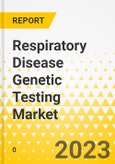This report comes with 10% free customization, enabling you to add data that meets your specific business needs.
Respiratory diseases continue to be a global health concern, with a significant impact on patient well-being and healthcare systems. Genetic testing has emerged as a crucial tool for understanding the genetic underpinnings of various respiratory conditions. This report provides an in-depth analysis of the global and regional trends in the respiratory disease genetic testing market, offering insights into market size, growth trends, regional disparities, and the impact of genetics on respiratory disease diagnostics and treatment.
Introduction
Respiratory diseases represent a diverse group of disorders, including asthma, chronic obstructive pulmonary disease (COPD), cystic fibrosis, and interstitial lung diseases, among others. The role of genetics in respiratory disease development and progression has become increasingly evident, leading to the growing importance of genetic testing in diagnosis, treatment, and prevention.
Market Overview
This section provides an overview of the global respiratory disease genetic testing market, including market size, growth trends, and key drivers.
Market Size and Growth.
- Factors contributing to this growth include the rising prevalence of respiratory diseases, advances in genetic testing technologies, and increasing awareness of personalized medicine.
Global Trends
- Personalized Medicine: Genetic testing allows healthcare providers to tailor treatment plans to an individual's genetic profile, enhancing treatment efficacy and minimizing adverse effects.
- Targeted Therapies: Genetic testing results are guiding the development of targeted therapies for specific respiratory diseases, leading to more effective and precise treatment options.
- Genome-wide Association Studies (GWAS): Ongoing GWAS are identifying novel genetic markers associated with respiratory diseases, expanding our understanding of their genetic basis.
Impact on Diagnosis and Treatment
- Genetic testing has a significant impact on the diagnosis and treatment of respiratory diseases.
- Early Diagnosis: Genetic testing enables early identification of individuals at risk, allowing for timely intervention and personalized treatment plans.
- Treatment Selection: Genetic profiles help clinicians choose the most suitable therapies, minimizing trial-and-error approaches and improving patient outcomes.
- Family Screening: Genetic testing supports family screening to identify genetic predispositions to respiratory diseases, allowing for preventative measures.
Challenges and Opportunities
This section outlines the challenges and opportunities within the respiratory disease genetic testing market.
Challenges
- Ethical and Privacy Concerns: The ethical use of genetic data and privacy concerns continue to be important considerations.
- Access to Testing: Disparities in access to genetic testing services exist, affecting the equitable provision of care.
Opportunities
- Advancements in Technology: Ongoing technological advancements are improving the accuracy and affordability of genetic testing.
- Integration with Healthcare Systems: Integration with electronic health records and healthcare systems is streamlining the use of genetic information in clinical practice.
This product will be delivered within 5-7 business days.
Table of Contents
Companies Mentioned
- 23andMe, Inc.
- Centogene A.G.
- GeneDx, Inc.
- Invitae Corporation
- Color Genomics
- Myriad Genetics
- Medicover Genetics
- Blueprint Genetics
- Prevention Genetics
- Quest Diagnostics
- Genesis Genetics
- ARUP Laboratories
- EGL Genetic Diagnostics
- Laboratory Corporation of America Holdings (LabCorp)








